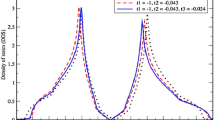Abstract
We consider the formalism of temperature Green’s functions to study the electronic properties of a semiinfinite two-dimensional graphene lattice at a given temperature. Under most general assumptions about the graphene boundary structure, we calculate the propagator in the corresponding diagram technique. The obtained propagator survives limit transitions between physically different states of the system boundary, i.e., a zig-zag edge and a boundary condition in the “infinite mass” approximation, and also correctly describes the problem where the electron–hole symmetry is violated because of the presence of an external potential applied to the graphene boundary. We illustrate the use of the propagator, its analytic properties, and specific features of calculating with it in the example of determining the dependence of the electron density on the distance to the system boundary.
Similar content being viewed by others
References
P. R. Wallace, “The band theory of graphite,” Phys. Rev., 71, 622–634 (1947).
C. Oshima and A. Nagashima, “Ultra-thin epitaxial films of graphite and hexagonal boron nitride on solid surfaces,” J. Phys., 9, 1–20 (1997).
K. S. Novoselov, A. K. Geim, S. V. Morozov, D. Jiang, Y. Zhang, S. V. Dubonos, I. V. Grigorieva, and A. A. Firsov, “Electric field effect in atomically thin carbon films,” Science, 306, 666–669 (2004).
M. I. Katsnelson, Graphene: Carbon in Two Dimensions, Cambridge Univ. Press, Cambridge (2012).
C. G. Beneventano, I. Fialkovsky, E. M. Santangelo, and D. V. Vassilevich, “Charge density and conductivity of disordered Berry–Mondragon graphene nanoribbons,” Eur. Phys. J. B, 87, 50 (2014).
C. G. Beneventano and E. M. Santangelo, “Boundary conditions in the Dirac approach to graphene devices,” Internat. J. Modern Phys. Conf. Ser., 14, 240–249 (2012).
A. R. Akhmerov and C. W. J. Beenakker, “Boundary conditions for Dirac fermions on a terminated honeycomb lattice,” Phys. Rev. B, 77, 085423 (2008).
A. A. Abrikosov, L. P. Gor’kov, and I. Ye. Dzyaloshinskii, Methods of Quantum Field Theory in Statistical Physics [in Russian], Dobrosvet, Moscow (2006); English transl. prev. ed.: Quantum Field Theoretical Methods in Statistical Physics (Intl. Series Monogr. Nat. Philos., Vol. 4), Pergamon, Oxford (1965).
A. N. Vasil’ev, Functional Methods in Quantum Field Theory and Statistics [in Russian], Leningrad State Univ., Leningrad (1976); English transl., Gordon and Breach, London (1998).
A. Nieto, “Evaluating sums over the Matsubara frequencies,” Comput. Phys. Commun., 92, 54–64 (1995).
Author information
Authors and Affiliations
Corresponding author
Additional information
This research is supported by St. Petersburg State University (Research Grant No. 11.38.185.2014).
Translated from Teoreticheskaya i Matematicheskaya Fizika, Vol. 190, No. 3, pp. 426–439, March, 2017.
Rights and permissions
About this article
Cite this article
D’yakonov, I.A., Komarova, M.V. & Nalimov, M.Y. Study of temperature Green’s functions of graphene-like systems in a half-space. Theor Math Phys 190, 366–377 (2017). https://doi.org/10.1134/S0040577917030060
Published:
Issue Date:
DOI: https://doi.org/10.1134/S0040577917030060




